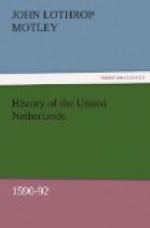The cavalry was divided into lancers and carabineers. The unit was the squadron, varying in number from sixty to one hundred and fifty, until the year 1591, when the regular complement of the squadron was fixed at one hundred and twenty.
As the use of cavalry on the battle-field at that day, or at least in the Netherlands, was not in rapidity of motion, nor in severity of shock—the attack usually taking place on a trot—Maurice gradually displaced the lance in favour of the carbine. His troopers thus became rather mounted infantry than regular cavalry.
The carbine was at least three feet long, with wheel-locks, and carried bullets of thirty to the pound.
The artillery was a peculiar Organisation. It was a guild of citizens, rather than a strictly military force like the cavalry and infantry. The arm had but just begun to develop itself, and it was cultivated as a special trade by the guild of the holy Barbara existing in all the principal cities. Thus a municipal artillery gradually organised itself, under the direction of the gun-masters (bus-meesters), who in secret laboured at the perfection of their art, and who taught it to their apprentices and journeymen; as the principles of other crafts were conveyed by master to pupil. This system furnished a powerful element of defence at a period when every city had in great measure to provide for its own safety.
In the earlier campaigns of Maurice three kinds of artillery were used; the whole cannon (kartow) of forty-eight pounds; the half-cannon, or twenty-four pounder, and the field-piece carrying a ball of twelve pounds. The two first were called battering pieces or siege-guns. All the guns were of bronze.
The length of the whole cannon was about twelve feet; its weight one hundred and fifty times that of the ball, or about seven thousand pounds. It was reckoned that the whole kartow could fire from eighty to one hundred shots in an hour. Wet hair cloths were used to cool the piece after every, ten or twelve discharges. The usual charge was twenty pounds of powder.
The whole gun was drawn by thirty-one horses, the half-cannon by twenty-three.
The field-piece required eleven horses, but a regular field-artillery, as an integral part of the army, did not exist, and was introduced in much later times. In the greatest pitched battle ever fought by Maurice, that of Nieuport, he had but six field-pieces.
The prince also employed mortars in his sieges, from which were thrown grenades, hot shot, and stones; but no greater distance was reached than six hundred yards. Bomb-shells were not often used although they had been known for a century.
Before the days of Maurice a special education for engineers had never been contemplated. Persons who had privately acquired a knowledge of fortification and similar branches of the science were employed, upon occasion, but regular corps of engineers there were none. The prince established a course of instruction in this profession at the University of Leyden, according to a system drawn up by the celebrated Stevinus.




